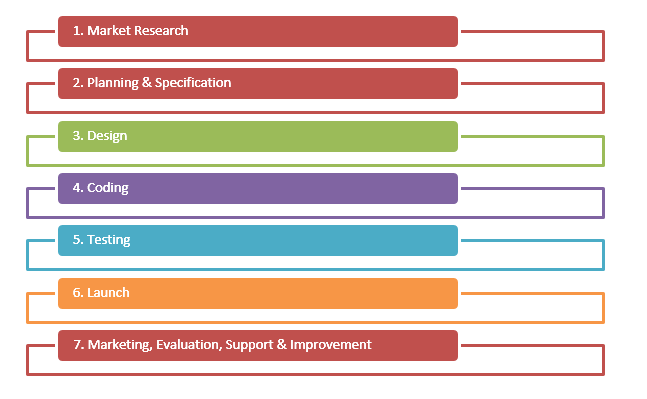How We Work
The purpose of this page is to describe how we work and what will happen if you decide to assign a digital marketing project to us.
Project Process
A professional web development project typically goes through 7-stages. These are as follows:
1. Market Research
To be successful we need to understand your customers, competitors as well as your own internal capabilities, processes and goals. What do your customers need and want? What are your competitors doing and saying? What can you currently deliver? What could you deliver in the future? What is special about you and your business? What do you want to be doing in 1, 3 and 5 years? What are your business goals? How big is the target market? What is the potential revenue? The answers to these questions are all compiled into a document that we call a Project Strategy.
2. Planning & Specification
The next step is to produce a specification and project plan.
a. Project Specification
The specification is the blueprint for your website and will answer questions such as: What will it do? What needs will it fulfil? Who is it for (website positioning)? How will the website work? What will be the personality of the website (website branding)? How big will the website need to be? How will it be designed? How will we protect the website against hackers? What will happen when a server fails? How much bandwidth and processing power will we need? What will happen if there is a large traffic spike? How will we backup the data? How will the website be restored after a disaster? How will we monitor the performance of the website? How will the website be updated? How will the website be promoted and marketed? How will we test the page designs? How will return-on-investment be monitored? How will we keep the website up-to-date with technological advances and best practices?
b. Project Plan
The project plan defines who will do the work, what tasks need to be completed, what special resources will we need to deliver the task, what is the timeline and what will be the deliverables.
3. Design
Design is the process of creating a visual solution to meet the requirements of the specification. Typical design tools include personas, sitemaps, style guides, storyboards, coded prototypes, user journeys and functional specifications.
4. Coding
Coding is the process of building the website, including any special modules and widgets.
5. Testing
Once the website has been coded it is necessary to test it for errors. There are three types of testing:
a. Normal Operation
Normal Operation involves testing typical user journeys to identify potential bottlenecks and errors
b. Ethical Hacking
Ethical Hacking involves testing for weaknesses in things like SQL injections, cross-site scripting (XSS), and cross-site request forgery (XSRF).
c. Disaster Recovery
Disaster Recovery involves deleting and restoring the website using data backups and snapshots.
6. Launch
Once the site has been tested it is ready for transfer to the live environment. Training materials and documentation is produced for operators and administrators and both are trained in their operational duties.
7. Marketing, Evaluation & Support
The website is now live and moves into the support phase of the project life-cycle.
Server performance, reliability and security is continually monitored and tuned. Security patches are applied as necessary to the operating system, middleware and applications. Databases are regularly backed up and server snapshots made. Server logs are monitored and hack attempts identified and thwarted.
Analytics are used to identify traffic sources, touch-points and to identify bottlenecks and poorly performing pages. These can then be improved using the techniques outline above.
Techniques such as SEO, PPC, SMM, Display Advertising, Display Remarketing and Email Marketing are used to promote the website.
A/B Testing is a tool that allows webmasters to vary factors such as calls-to-action, images, layout and design to see what effect the changes might make on the performance of the website. Successful websites use these techniques throughout their whole life and it is not unusual to see one page outstrip another by more than 500% in terms of sign-ups and sales.
